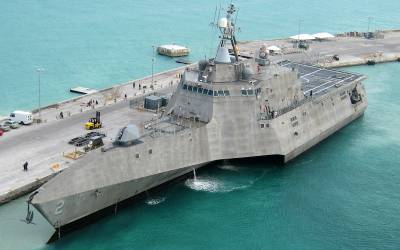Americas Lockheed Martin Rotary and Mission Systems won a $34,142,015 cost-plus-fixed-fee and cost-plus-incentive-fee type modification to exercise options for AEGIS development and test sites operation and maintenance at the Combat Systems Engineering Development...
University-related Articles
Lockheed Tapped For Trident Integration Into Columbia/Dreadnought | Russia Expands Military Base In Mali | India To Commission Seahawk
Americas Lockheed Martin Space won a $109.3 million contract to support the integration of the Trident II (D5) Missile and reentry subsystems into the Common Missile Compartment for the US/UK Columbia/Dreadnought submarine construction programs. Work is expected to be...
Trident II D5 Missile: Keeping Up with Changing Times
Trident II D5 Test Launch (click to view full) Nuclear tipped missiles were first deployed on board US submarines at the height of the Cold War in the 1960s, to deter a Soviet first strike. The deterrence theorists argued that, unlike their land-based cousins,...
Boeing Tapped By Navy For P-8A Delivery | F-16 Sale To Turkey On Track | Poland Boosts Military With New Carriers
Americas Boeing won a $3.4 million deal for the procurement and delivery of 17 Lot 13 P-8A Multi-Mission Maritime Aircraft (14 for the government of Canada and three for the government of Germany), as well as associated non-recurring engineering. Work will be...
LCS: The USA’s Littoral Combat Ships
Austal Team Trimaran LCS Design (click to enlarge) Exploit simplicity, numbers, the pace of technology development in electronics and robotics, and fast reconfiguration. That was the US Navy's idea for the low-end backbone of its future surface combatant fleet....
Sikorsky Plans New VTOL Systems | Nigeria Gets CN235-220 From Indonesia | Putin Agains Warns Of Risk Of Nuclear War
Americas Boeing won a $21.3 million firm-fixed-price contract modification for the F-15 Eagle Passive/Active Warning Survivability System. Work will be performed at Nashua, New Hampshire, and is expected to be completed by November 30, 2025. The Air Force Life Cycle...
USAF Completed Red Hawk Test | UNMAS Gets Donations For Humanitarian Mine Actions In Ethiopia | Germany Acquires US High Frequency Radios
Americas General Dynamics Land Systems won a $210.3 million contract for the purchase, warehousing, repair, issue, shipment, disposal, obsolescence management and configuration management of parts to support the Stryker Brigade Combat Team. Bids were solicited via the...
AMRAAM: Deploying & Developing America’s Medium-Range Air-Air Missile
AIM-120C from F-22A (click for test missile zoom) Raytheon's AIM-120 Advanced, Medium-Range Air to Air Missile (AMRAAM) has become the world market leader for medium range air-to-air missiles, and is also beginning to make inroads within land-based defense systems. It...
Lockheed Tapped For F-35 Testing | R2S Started Construction On Tamir Manufacturing Facility | US Delivered Hercules To Philippines
Americas Triumph Gear won a $18.5 million deal for the repair of one item that is part of the V-22 pylon conversion actuator system. All work will be performed in Park City, Utah. Work is expected to be completed by April 2025. Naval Supply Systems Command Weapon...



